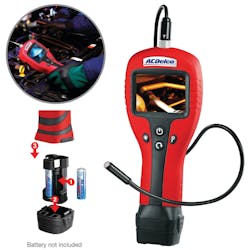Tech Tip: How to choose the right video inspection camera
When selecting inspection cameras, it comes down to two basic criteria most professionals and semi-pros will want to keep in mind: Price and features.
(For more information on making a decision between basic units and full-featured units, click here.)
Video inspection cameras now come with small screens, extra-large screens, color, black and white, tiny camera heads (5.5mm and smaller for diesel applications for example), wireless features, built-in and removable memory, PC connectivity, built in batteries, and so on… the range of features continues to expand and the complexity of deciding on what is important and determining a good value is even more of a challenge than ever before, and it is likely to continue to worsen.
When you look at the above it seems almost impossible to confidently feel that you would be making a good decision, and who has time to do all this homework, but it really can be quite simple. The same challenge was there in the early days of cordless drills or cordless impacts, for example, and specific criteria became the norm for a means of measurement.
Some features to consider:
Video screen size
Often it is thought the larger the better but it will impact the places you can get into while working with the unit, also, too small and it becomes very difficult to see the image at all.
Camera head diameter
8mm is standard for most automotive applications, 5.5mm or smaller is standard for diesel.
Camera head LED (Y/N?)
Having an LED on the camera is important, allowing the image inspected to be well lit.
Camera cable length
Too short of cable and accessing the area to be inspected may be difficult to reach.
Battery (built in: Y/N?)
While a good idea, if the battery dies, the tool is useless until it is recharged.
Battery run time?
Most often cameras are used in short bursts, therefore excessively long run-times are not necessarily needed.
Color Screen (Y/N?)
Does the unit take pictures? Video?
With Audio? (this is important, because the user can make verbal notes while recording)
Memory (Y/N?)
Built in or external?
How much memory?
One handed operation (Y/N?)
This is useful if you cannot hang the unit or set it down, you need to use one hand to operate the unit while the other operates the camera cable.
Video Flip (Y/N?)
This is a useful feature if your camera cable gets twisted while being inserted into the area and you need to re-orient the image.
Information provided by: ACDelco
